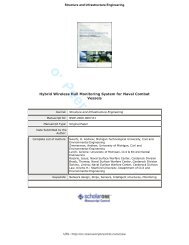Research Proposal - Engineering Informatics Group - Stanford ...
Research Proposal - Engineering Informatics Group - Stanford ...
Research Proposal - Engineering Informatics Group - Stanford ...
You also want an ePaper? Increase the reach of your titles
YUMPU automatically turns print PDFs into web optimized ePapers that Google loves.
movements. We envision that these fast algorithms can provide a scalable platform<br />
to handle thousands of agents for crowd simulation.<br />
• We envision that the prototype system will be extended and used to integrated with<br />
other engineering analyses, such as performance-based assessments of facilities and<br />
spaces, design of egress and safety/emergency plans. The framework is currently<br />
being re-designed to provide sufficient modularity for such integration.<br />
3.3 <strong>Research</strong> Impact<br />
In safety engineering, because few efforts have been conducted to study the core of<br />
crowd safety problem – nonadaptive crowd behavior – from human psychological and<br />
sociological perspectives, the proposed research is expected to fulfill this gap and will<br />
subsequently lead to significant contributions to the field of crowd safety research, which,<br />
due to recent natural and man-made events, is fast becoming an important issue in<br />
facility design. A simulation tool such as the one proposed can be used to help facility<br />
design, emergency exits, evacuation plan. In addition, these types of simulation can help<br />
develop a wider range of possible solution to crowd problems. The tool can provide<br />
valuable information to guide the planning process, for construction, to develop crowd<br />
management strategies and for dealing with emergencies.<br />
3.4 Milestones and Anticipated Risks<br />
We anticipate that by the end of the first year period, the basic issues related to “nonadaptive<br />
crowd behaviors” will be thoroughly reviewed and the prototype system will be<br />
re-designed for modularity and scalability. For the proposed second year research period<br />
from September 2005 through August 2006, the research milestones are set up as<br />
follows:<br />
• By the end of Fall Quarter 2005 – we plan to complete the preliminary implementation<br />
of a scalable simulation system, which allows (1) simulations for a significant number<br />
of agents in the crowd, and (2) predefined deterministic or random assignments of<br />
individuals in design spaces.<br />
• By the end of Winter Quarter 2006 – we plan to test and to complete the<br />
implementation so that we can compare the simulated results and replicate the<br />
patterns of some historical overcrowding incidents and case studies on some real-life<br />
crowd settings (e.g., sport events and subway stations).<br />
• By the end of Spring Quarter 2006 – we plan to analyze our findings and, if<br />
necessary, to develop a tool that will enable the analysis of large scale simulated<br />
results which may involve hundreds of randomized simulations for particular settings.<br />
• By the end of Summer Quarter 2006 – we plan to complete a detailed report on this<br />
study. Furthermore, we anticipate that we will produce a range of experimental<br />
results by applying the simulation system to assess the performance of a variety of<br />
real facilities.<br />
This research is a high-risk, high-payoff, interdisciplinary project (with participants from<br />
Civil <strong>Engineering</strong>, Computer Science and Sociology) that could lead to significant<br />
advancement in facility engineering and design. We anticipate the following risks:<br />
• Human and social behaviors are complex subjects. The crowd behavior model that<br />
we aim to develop may not be sufficiently general for a broad range of scenarios. We<br />
address this risk by design the system with sufficient flexibility and modularity to allow<br />
further investigation of crowd dynamics and incorporation of new behaviors as they<br />
are discovered.<br />
Law, Latombe, Dauber Egress Simulation 8






